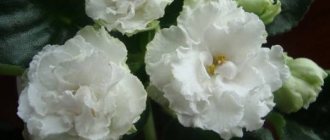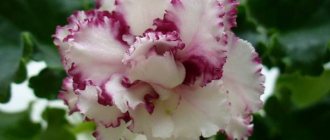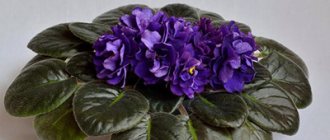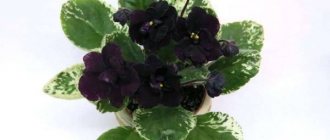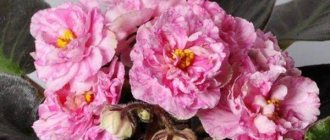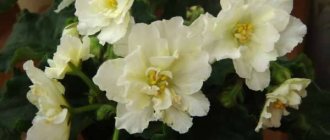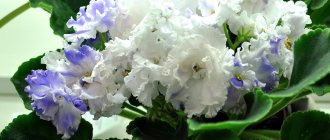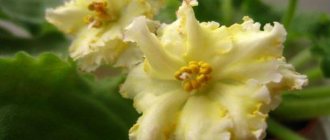Violets of any color are mysterious, mysterious, slightly mystical flowers , and lilac ones are no exception.
In this article we will talk about different varieties of lilac violets, which differ in shape, size, and shades.
Get acquainted with the information and advice from experienced flower growers, choose those that suit you , and photos of lilac violets will help you with this.
Energy of color
The popularization of violets has been in full swing lately. Thanks to the efforts of breeders, more and more people are decorating their homes with Saintpaulia . Beginning collectors are often afraid of failure when purchasing a particular variety.
The lilac violets described in the article are suitable for both beginners and experienced gardeners. What attracts these plants and why are they so popular?
The color range of lilac shades is large . There are not many of them in nature. Therefore, violets bred by creative and extraordinary people help bring harmony to the space of the house. It's warmer and more comfortable with them.
From all the variety of shapes - pansies, stars, bells, bowls, wasps - you can choose the one that suits you.
Terry, semi-double, simple, in the form of carnations or scalloped, with a border, fringe - they are equally beautiful and unique.
Lilac violets are fascinating, they have a mysterious energy that makes you kinder and calms you down. Chimeras and Saintpaulias with prints leave no one indifferent.
Important! It turns out that anyone can find a lilac Saintpaulia to their liking or create their own unique collection.
Features of flowering, growth and reproduction
At home it develops quite quickly . In a warm and humid place it will be able to produce buds quite quickly. With sufficient watering, it begins to bloom 6-7 months after planting. With proper care it can bloom up to 10 months a year. Sometimes you can find voluminous flowers at a time when the leaves are hard to see.
When propagated, it may give a slightly different color . Each of them is unique and not repeated. It all depends on the age of the plant. The older it is, the lighter the buds of new shoots turn out. This is due to the amount of nutrients that the flower can transmit.
Saintpaulia blooms with large flowers.
“Running on the waves” has dark blue petals closer to the core and light ones towards the edges. Over time it may turn completely blue. With proper care, every year the buds become more wavy and lush.
No matter how hard gardeners try, it is impossible to find abundant flowering and a large head . This variety does not have the ability to grow to such large sizes. Otherwise, the remaining parts will not have enough nutrients.
Lilac violets
With border or spots
Stone Flower
The author of the original variety is Konstantin Morev. Saintpaulia grows slowly and loves natural light. The stone flower tolerates drought calmly. Forms sports.
The flowers are double and semi-double stars, up to 4 cm, the color is bright, raspberry-violet, the border is yellow-green. Petals have a dense structure.
The leaves are dark green, large, wavy. The socket is standard, symmetrical, even.
Attention! It blooms for a long time, does not form a hat, and produces few flower stalks.
Jan-Merilen
The author of the bright, rich variety is Natalya Puminova (Moscow). Saintpaulia pleases with cap blooms , often and in large quantities. Forms sports.
The flowers are large half bells, the color is lavender with a soft lilac tint, a bright blue fantasy pattern and a pink eye. The peduncles are strong and tall, holding 3-4 flowers.
The leaves are shiny, bright, light green. The socket is standard, smooth.
Shining stars
These mysterious and delicate lilac violets with a white border were created by Konstantin Morev.
Saintpaulias love good watering and sufficient natural light.
The flowers are very large stars up to 6 cm, the color is pastel lilac-violet, there is a white eye in the middle, and a corrugated white border along the edge of the petals. The flowers last for 2-3 weeks, but are classified as fallout. Peduncles grow tall and may bend slightly.
The leaves are medium green, with white variegation along the edges. The rosette is standard, large, with long petioles.
Summer twilight
The author of the unusually beautiful violet is Konstantin Morev .
Summer twilight - an unpretentious variety, blooms for a long time , at lower temperatures the border on the flowers becomes wider. Likes watering the soil from above or using a wick. Propagates easily , preferably by cuttings.
The flowers are large, 5-6 cm, double, color is lilac-violet, the eye is white, the edge of the velvet petals has a white border.
Peduncles are low and durable. Sometimes, due to the heaviness of the flowers, they may bend slightly downward.
Leaves are variegated and green. The socket is standard, looks smooth and neat.
Large-flowered
AV-Russian Style
The author of the elegant Saintpaulia is the Violet Maker (Alexey Tarasov, Moscow). Not capricious . Does not require special care.
The flowers are large stars with a diameter of up to 7 cm, double, the color is lilac-violet, with a slight flicker, the border is white and green. The petals are dense, elongated, with a waxy structure.
It blooms super profusely and forms a beautiful head. Short, strong peduncles hold flowers well.
Leaves are medium green. The socket is neat, looks compact, standard.
Lilac beauty
The author of this marvelous variety is the spouses Boris and Tatyana Makuni . Saintpaulia blooms powerfully, abundantly, for a long time. Does not require special care.
The flowers are large, graceful, fringed, the color is pale lilac, warm, the edging is thin dark purple, dark lilac dots are located closer to the center. Peduncles are strong.
The leaves are round in shape, slightly wavy along the edges, green, slightly elongated. Has a large socket.
RS-Magic of Spring
The variety is the result of breeding work by S.N. Repkina , presented to flower growers in 2013.
Species affiliation
Photo and description of the violet RS-Magia Vesny Violet characterizes it as follows:
- belongs to the standard type , as it forms a leaf rosette of not very large diameter;
- according to the size of the corolla - large-flowered,
- color: finger Saintpaulia.
Description
The plant forms an even, dense rosette of leaf plates of a round configuration. The leaves are a dark shade of green with a slight tint of brown, have a slight waviness of the edges, a glossy surface and a thin coating of villi.
Large corollas consist of a layering of petals with wavy tips, which creates a feeling of strong double flowers . On the white petals of the buds, spots of lilac-blue tones with varying densities of tonality are scattered in a chaotic manner.
Features of growth and flowering
Varietal violets “Magic of Spring” have no significant differences:
- grow and develop quite quickly;
- bloom readily, forming lush flower caps.
The intensity of bud formation and the increase in the fullness of the corollas increases at first with each new flowering.
The presence of blue spots and their tinting according to the tint scale depends solely on the characteristics of the specimen.
Saintpaulias appreciate a little help in the rosette formation process. You can make a corset for them, and an even rosette will be obtained if the plant is regularly rotated a few degrees relative to the light source.
Nuances of maintenance and care
The variety is suitable for cultivation by beginners using the experience and advice of experienced gardeners. Like all white violets, this variety loves good light, but does not tolerate bright rays, so it requires shading during the midday hours.
ADVICE! You should not allow the Magic of Spring to be affected by extreme heat (more than 30°C) - this can lead to shredding of the buds and paleness of the leaf rosette. But low temperatures and drafts also disrupt the decorative appearance of violets.
When watering at the root, under no circumstances should drops of water fall on the leaves and flowers - this will lead to the formation of stains and rot.
Reviews
Stanislav Sergeevich. “I have been working with violets for many years, I have an extensive collection of Svetlana Nikolaevna’s varieties. What is attractive about them is their easy care and low plant requirements. The “Magic of Spring” variety captivated us with its scattering of delicate lilac spots on the petals. I’ll leave it in the collection.”
Olechka. “Mom has a lot of different violets on the windowsill, but I like a beautiful flower that Mom calls the Magic of Spring. She says he is magical. I know this too, because the violet, with its wonderful outfit, looks like my Princess Sofia.”
TOP 10 most popular varieties
AB-Fourth Dimension
An amazingly beautiful lilac violet with white fringe belongs to the selection of Violetkovod (Alexey Tarasov, Moscow).
The flowers are simple stars, the color is dark blue, with dark lilac fantasy, raspberry dusting and rare pink peas. Petals with a dense structure, a white border along the edge.
Peduncles are short and strong. The flowering is super abundant and lasts a long time.
The leaves are medium green, slightly toothed, and wavy. The socket is standard.
EK-Tibet
The author of the bright, contrasting variety is Elena Korshunova (Tolyatti). The name is inspired by the pre-dawn views of Tibet.
The flowers are very large, semi-double, the color is in the form of purple-violet spots on the petals, a white eye and a wide snow-white frill. The petals are wavy and airy.
Peduncles are slender and strong. The violet blooms wildly, the bouquet does not fall apart.
The leaves are deep green, round, and medium-sized. The socket is smooth and compact.
EK-Lilac aura
Exquisite, romantic light lilac violet from the collection of breeder Elena Korshunova (Togliatti).
Saintpaulia is not capricious , it is easy to tame and care for. In the first flowering it can be upsetting due to the untidy shape of the flowers. Don’t be upset; as you grow up, EK-Lilac aura will delight you with a first-class bouquet.
The flowers are large, 6 cm each, the color is iridescent lilac, with a purple eye. The fringed petals have a purple edge. It blooms with a beautiful hat. Peduncles are strong.
The leaves are dark green. The rosette is luxurious, exhibition, smooth.
Apache Jewel
The authors of this cute variety are James Calvin and Lenora Munk , famous breeders from Texas, USA. Saintpaulia blooms in bouquets, profusely, for a long time, about 2 months.
The flowers are semi-double and simple, up to 5 cm in size, lilac in color, with a dark eye in the middle. The edges of the petals are dark purple. The shade of the lower petals is lighter.
The leaves are openwork, dark green, variegated along the edge. The socket is smooth, small, standard.
Cosmic Blast
The author of the original variety is Paul Sorano . Saintpaulia is unpretentious, grows quickly, and blooms for a long time. Needs good lighting. Can go into sports.
The flowers are stars, very large, up to 6 cm, dark purple in color. Petals with corrugated edges, a thin white border and bright fuchsia spots. Peduncles are long.
The leaves are variegated, dark green with a white edge. the socket may pull upward.
AB-Lace lilac
The author of this amazingly airy variety is Violetvod (Alexey Tarasov, Moscow).
The flowers are large charming stars measuring 6.5 cm, the color is white with lilac shadows. The petals are dense, wavy, edged with a thin green ruffle. In a cool place the border becomes brighter. Peduncles are short, strong, and form a cap.
The leaves are a juicy bright green color, the structure is slightly wavy. socket , compact, neat shape.
Important! You have to wait a long time for flowers, but they bloom for a long time.
Sora Fuzzy Face
Sora Fuzzy Face translates as “fuzzy face” or “fuzzy face.” The authors of the variety are Barbara Werness and Ruth Bann (B. Werness / R. Bann) - Saintpaulia breeders from Minnesota, USA.
The flowers are charming, discreet pansies in 2 tones: gray-lavender and smoky blue. Petals slightly elongated. Blossoms like a bouquet. Shades can change - lighten or darken. Peduncles are long.
The leaves are green, elongated, slightly variegated. The socket is even, standard.
EK-Lavender Mirage
Bright Saintpaulia selected by Elena Korshunova (Tolyatti). Violet loves natural light and feeding.
The flowers are lovely large double and semi-double, lavender blue with shimmering fantasy purple-blue splashes. It blooms very profusely. The hat is thick and luxurious. It happens that flowers with different shades bloom on one rosette. The peduncles are strong, bearing 5 or more buds.
The leaves are dark green. The rosette is standard, neat, 30 cm. Leaves can lift up.
LE-Lilac tenderness
The author of the luxurious variety is Elena Anatolyevna Lebetskaya (Ukraine). Saintpaulia reproduces well by stepsons and blooms for a long time.
The flowers are lush double stars, large, up to 6 cm, the color is soft lilac. Petals are corrugated. In the first flowering there are few peduncles. They do not form a cap.
The leaves are oblong, light green. The rosette is standard, large, not compact, with few leaves.
AE-Lilac whirlwind
The unusually delicate white-lilac violet is the fruit of the labors of breeder Evgeny Arkhipov (Moscow).
The plant does not require special care. Blooms profusely almost all year round.
The flowers are double, airy, white with a pink center and lilac fantasy. Forms a beautiful bouquet. It becomes brighter with each bloom.
The leaves are medium green, wavy, growing in the form of a small, neat, even rosette.
PC-Ancient Magic
Another excellent result of breeding research by S.N. Repkina, received in 2014.
Species affiliation
Based on the size of the leaf rosette, violet RS-Ancient Magic can be safely described as a standard.
Description
A magnificent variety with magical flower colors. The plant forms a neat, compact rosette. The dark green leaf blades are enlivened by a light green central vein.
The leaves are elongated-oval in shape with smooth wavy edges and slight villi. The reverse side is painted in a reddish tone.
Violet can be called a contrasting variety for its unforgettably beautiful color palette. Large buds open with medium-double corollas. Petals with slightly wavy edges enchant with the mysterious color of purple fuchsia with white patterns along the contour.
Features of growth and flowering
The variety blooms very profusely in a cap type. Despite the neatness of the outlet, sometimes due to an oversight the leaf plates are pulled upward.
The splendor of each flower and the decorative appearance of the entire violet gradually intensifies from flowering to flowering.
The color scheme has some variability within the lilac-blue range with purple streaks.
The width of the white patterned tape depends on the specific specimen and the conditions of detention.
Nuances of maintenance and care
The bright color and abundant flowering of Ancient Magic require regular feeding and adherence to watering regimes.
When applying fertilizers, you should pay attention to the percentage of chemical elements in different stages of violet life. When flowering, it is important to reduce the amount of nitrogen, otherwise Saintpaulia will grow.
ATTENTION! Watering violets Ancient magic should be regular, but not abundant.
After watering, remove excess water from the pan. This will protect the specimens from rot. For the same purpose, a good drainage layer is needed in the flowerpot.
Reviews
Maria Alexandrovna. “I bought a dying plant at a sale and went out. What a surprise it was when the violet bloomed. It turned out to be Ancient magic. I’ve been admiring the exotic beauty for a week now.”
Nina Vasilievna. “I like to do everything in floriculture, as in life, according to the rules - sometimes this saves the life of plants. I have never neglected drainage, so my Ancient Magic, recently donated and already transplanted, calmly acclimatized and steadfastly endured the procedure.”
Caring for a plant at home
Conditions of detention
Proper watering and fertilizing
Watering is the most important activity. Incorrect, irregular, or excessive watering will lead to the death of the plant.
IMPORTANT! Watering is carried out carefully, trying to avoid moisture getting on the leaves, and most importantly, the growing point of the violet.
The water used to water violets must first be left standing for at least two days. Water temperature is room temperature or slightly higher (1-2 degrees)
For violets, two types of watering are used:
- Watering from above. Experienced violet lovers use a 20-50 ml medical bulb with a long spout. A syringe allows you to water plants in doses and in a controlled manner.
pros:
- We control the volume of liquid;
- Water passes through the entire volume of the pot, washing out decay products and reducing the risk of alkalization and rotting;
- When watering with a syringe, the soil is not washed away.
Minuses:
- You may not completely wet the earthen ball;
- With abundant watering, beneficial substances are washed out of the substrate.
- Irrigation by immersion. With this method of watering, pots with violets are immersed in a container of water to about 1/3 of the height.
It is not often that gardeners use watering violets by immersion in water.
pros:
- Water moves from bottom to top, nutrients are not washed away;
- The soil is not washed away;
- High-quality soil moisture.
Minuses:
- The volume of liquid entering the pot is not controlled;
- There is a risk of soil alkalization;
Advice! To eliminate risks and bring the greatest benefit to violets, watering methods should be alternated.
The dry surface of the substrate indicates that the plant needs to be watered. Excessive or frequent watering can cause rotting of the root system and acidification of the soil. How often to water and how much water depends on:
- Soil composition;
- Pot volume;
- Air humidity;
- The size and age of the plant and other factors.
Lighting and air temperature
In the hot season, diffused light is preferable , this happens on eastern and western windows. In winter, plants need bright sunlight coming from southern windows.
The optimal temperature for growth and development is considered to be 20 ± 3 0C. Temperatures below 130C and above 300C will cause plant death.
Effect of air humidity
Try to provide Saintpaulias with air with humidity in the range of 60-70% . In winter, such indicators can be maintained artificially, while keeping the pots away from radiators.
Soil requirements
- Nutritious;
- Loose, breathable;
- With a slightly acidic reaction;
- Not prone to compaction.
Approximate composition of the soil mixture for violets:
You can prepare soil for violets with your own hands.
- Vermiculite or Perlite – 30%;
- Sphagnum (coconut fiber) – 30%;
- Turf (coniferous, deciduous) land – 30%;
- Nutrient soil – 10%.
Pruning and hygiene
An important part of care is the formation of a rosette of leaves . Usually, to enhance decorativeness and for hygienic purposes, the top three tiers of leaves are left, the rest are removed. In addition, they cut off:
- Leaves with damage and yellowness;
- Empty flower stalks;
- Extra buds.
Dusty Saintpaulias need a hygienic shower . A weak pressure of warm water will not harm the plants, but will wash away dust and refresh paints. After bathing, leave the flowers to dry in a dark place, otherwise sunlight will cause burns on wet leaves.
Reproduction methods
Saintpaulia varieties NiL-Evdokia and RM Evdokia, reproduce :
- Children who grew up on the mother plant;
- Leaf cuttings;
- Peduncle cuttings.
Transplant rules, rejuvenation
An adult Saintpaulia is transplanted as follows:
- Loosen the lump of substrate with a sharp object;
- Remove the lump, trying to free the roots from the old substrate as much as possible;
- For an old plant, cut off the lower third of the roots with a sharp knife;
- Plant the violet in new soil.
For long-term growth, the violet must be rejuvenated after a few years.
Important! Choose a new violet pot with a diameter of no more than 9 centimeters.
Saintpaulias are rejuvenated after 2-3 years . Using a sharp knife, cut off the upper part of the plant, leaving three rows of leaves and a part of the stem 5 mm long. Dip the stem into water, when new roots appear, plant it in the ground.
Advice from experienced flower growers
- The main rule for those who decide to bring Saintpaulia into the house is creating an atmosphere of love, calmness, kindness, selflessness. They say that they subtly feel the soul of a person and will not grow where evil and greed reign;
Violet Your Majesty prefers care and attention. - When buying Saintpaulias in a store, you should not opt for Dutch violets . The reason is simple - they bring us mainly third-rate plants grown using technical soil. They rarely survive transplantation. It is better to purchase them at exhibitions;
- The first flowering of a young plant will not give the magnificent result that is expected from it. Experts advise cutting off the first flower stalks. Then, after 2-3 months, the violets will delight you with their terry splendor.
Advice! To obtain an even, slender plant, it must be turned to the light in different directions.
Reviews
Elena - “The Lady in Red” was sent to me by a friend on the violet growers forum, in the form of a stepson. I don’t think twice and plant all the violets in purchased soil, adding a little perlite. There's just no time for dancing with a tambourine. The plant began to bloom within a couple of months, growing by leaps and bounds. The flowers are very beautiful, rich wine color"
The variety has many positive reviews.
Maria - “Personally, the variety seemed very problematic to me. Either the leaves stretch out, then the flowers are small, or the roots rot. Apparently, my conditions did not suit him. I gave it to a friend, she seems to be in bloom.”
Elizaveta - “I really liked the variety. However, I don’t have a shelving unit and all the violets grow on the window. I don’t like capricious varieties, I get rid of them quickly. “Lady in Red” has become my favorite - the flowers are simply stunning. But sometimes the flower stalks can’t stand it.”
Kira - “I received this violet as a bonus for my order. Since the colors did not inspire me at all, I simply planted the leaf in the ground, without any greenhouses. Imagine my surprise when the variety gave birth to babies before anyone else! I currently have 2 plants grown from the same leaf. One stands in the room on the dressing table as a decoration (while blooming non-stop), and the other is in the kitchen. No problems, I just fertilize it once a month and replant it in fresh soil every six months.”
Antonina - “The variety is a classic, but I didn’t like it. Very spreading rosette, few flowers. I couldn’t determine the optimal watering - I constantly dried it out, then flooded it, while trying different frequencies and amounts of water. Perhaps I just don’t have enough experience.”
